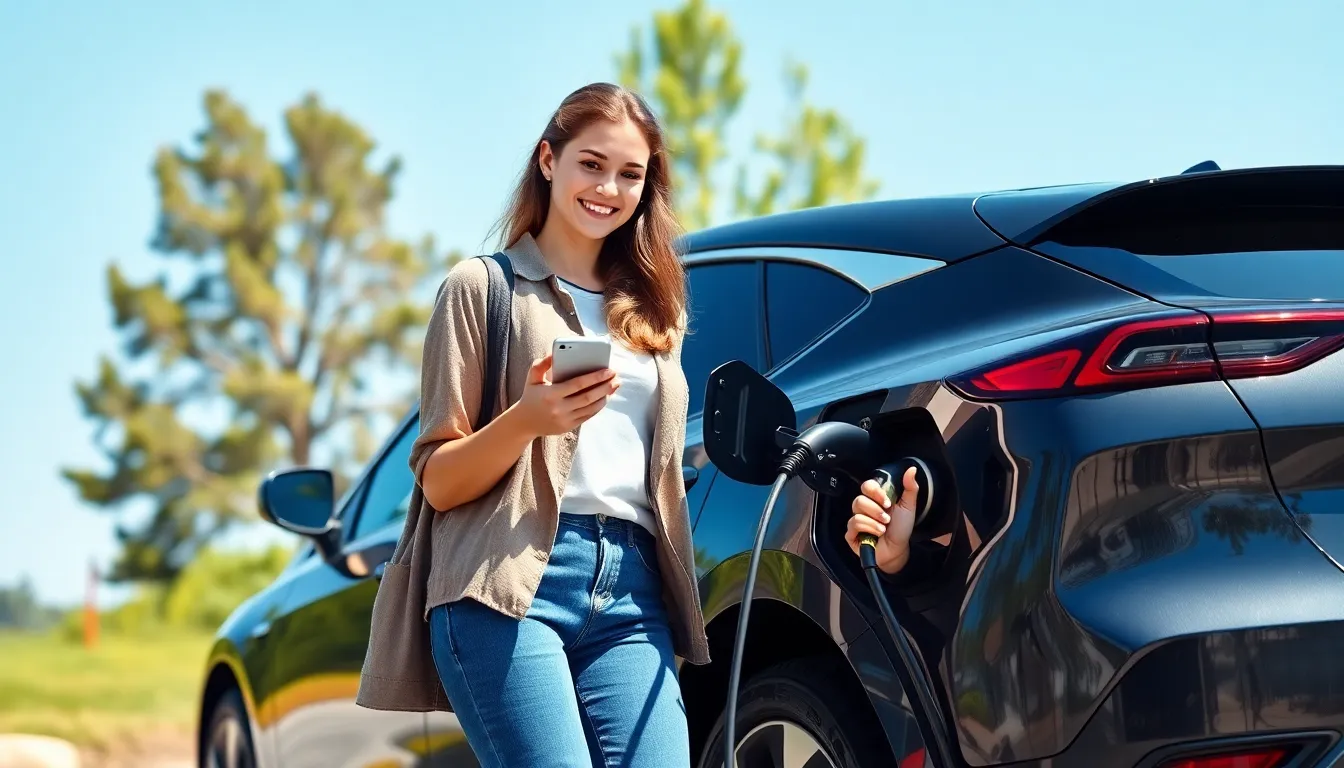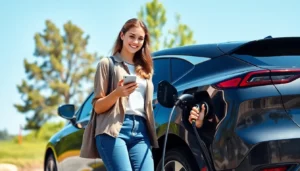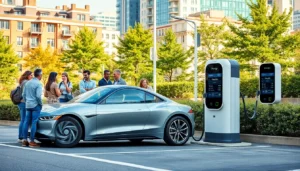In a world where gas-guzzlers are slowly becoming the dinosaurs of the automotive realm, electric drivetrains are taking the wheel—and they’re not just coasting along. These high-tech marvels are powering the future of transportation, combining efficiency with a dash of eco-friendly charm. Who knew going green could feel so good?
Table of Contents
ToggleOverview of Electric Drivetrains
Electric drivetrains represent a revolutionary shift in vehicle propulsion. These systems enhance efficiency and significantly reduce environmental impacts.
Definition and Components
Electric drivetrains consist of several crucial elements. An electric motor converts electrical energy into mechanical power. A battery pack stores this energy, providing the necessary charge for operations. Additionally, an inverter translates the electric current, ensuring proper functionality between components. Regenerative braking captures energy during deceleration, increasing range and efficiency. Together, these components create a seamless and powerful driving experience.
Benefits of Electric Drivetrains
Numerous advantages exist with electric drivetrains. They produce zero tailpipe emissions, contributing to cleaner air. Energy efficiency rates often surpass 90%, making them more effective than gas engines. Maintenance requirements decrease since fewer moving parts are involved. Furthermore, the quietness of electric motors enhances driving comfort. Cost savings frequently arise from lower operational costs and available tax incentives. Overall, electric vehicles present a compelling choice for eco-conscious consumers.
Types of Electric Drivetrains
Electric drivetrains come in several types, each offering distinct technical features and advantages. Understanding these options helps consumers make informed choices.
Battery Electric Vehicles (BEVs)
Battery Electric Vehicles (BEVs) operate solely on electricity, utilizing large battery packs to power electric motors. These vehicles emit no tailpipe emissions, aligning with environmental goals. Charging typically occurs at home or public charging stations, offering convenience to users. Long-range models are available, enabling drivers to travel significant distances on a single charge. High energy efficiency also characterizes BEVs, maximizing battery output. Well-known examples include the Tesla Model S and Nissan Leaf.
Plug-in Hybrid Electric Vehicles (PHEVs)
Plug-in Hybrid Electric Vehicles (PHEVs) blend internal combustion engines with electric drivetrains. These vehicles can operate on electric power or switch to gas when needed. Charging PHEVs can happen through standard outlets, making them versatile for various users. Drivers enjoy reduced fuel consumption and lower emissions compared to traditional vehicles. Many PHEVs have all-electric ranges that allow for short trips without gas. Popular models include the Toyota Prius Prime and Ford Escape PHEV.
Fuel Cell Electric Vehicles (FCEVs)
Fuel Cell Electric Vehicles (FCEVs) generate electricity through a chemical reaction between hydrogen and oxygen. This process produces only water vapor and heat as byproducts. FCEVs showcase quick refueling times, often comparable to gasoline vehicles. Driving ranges are extensive, thanks to the efficiency of hydrogen fuel cells. Infrastructure for hydrogen refueling is still developing, though several areas are expanding availability. Notable examples include the Toyota Mirai and Hyundai Nexo.
Performance and Efficiency
Electric drivetrains deliver impressive performance coupled with enhanced efficiency. Understanding these key aspects remains essential for consumers exploring electric vehicle options.
Torque and Acceleration
Electric motors generate maximum torque instantly, allowing for rapid acceleration. BEVs, such as the Tesla Model S, showcase this capability with 0 to 60 mph times often under 3 seconds. High torque output enables a thrilling driving experience, making electric cars feel lively and responsive. These drivetrains also provide smooth power delivery, eliminating the traditional lag experienced in gas-powered vehicles. Car manufacturers leverage this immediate torque to enhance driving dynamics, allowing vehicles to outperform many conventional counterparts in acceleration tests.
Energy Consumption and Range
Energy consumption defines how efficiently an electric vehicle uses its battery. BEVs like the Nissan Leaf demonstrate an average consumption of about 4 miles per kWh, contributing to extended driving ranges. Range anxiety remains a common concern, yet advancements in battery technology have allowed models to achieve ranges exceeding 300 miles on a single charge. PHEVs enhance flexibility by offering electric-only driving with an internal combustion engine for longer trips. Optimizing energy use results in reduced costs per mile, making electric vehicles both economical and appealing options for users.
Challenges Facing Electric Drivetrains
Electric drivetrains face several key challenges impacting their broader adoption and efficiency.
Infrastructure Development
Charging infrastructure development poses a significant challenge for electric drivetrains. Insufficient charging stations limits convenience and can discourage potential buyers. Only about 40% of U.S. charging stations are located in public areas, making accessibility a concern. Expanding this infrastructure requires investment and coordination among stakeholders, including government entities and private companies. Furthermore, faster charging solutions are necessary to reduce wait times and increase electric vehicle adoption rates. Addressing these infrastructure gaps is crucial for supporting a widespread transition to electric vehicles.
Battery Technology and Recycling
Battery technology advancements continue to influence electric drivetrain efficiency and sustainability. Current lithium-ion batteries have limited range and lifecycle, necessitating ongoing research. Developing solid-state batteries promises greater energy density and safety, potentially doubling vehicle ranges. Recycling practices also require improvement, as handling and repurposing batteries present environmental challenges. Only 5% of lithium-ion batteries are recycled, leading to valuable materials ending up in landfills. Enhanced recycling processes could recover critical resources like lithium and cobalt, promoting a circular economy. Investing in these technologies is essential for ensuring the long-term viability of electric drivetrains.
Future Trends in Electric Drivetrains
Electric drivetrains are set to evolve significantly in the coming years, driven by innovations and growing market demand.
Advancements in Technology
Improvements in battery technology lead the charge in electric drivetrain innovations. Solid-state batteries are emerging as a promising alternative to traditional lithium-ion variants, offering enhanced energy density and safety. These new batteries can increase the range of electric vehicles, making them more appealing for long-distance travel. Electric motors continue to advance, enhancing efficiency and power output. Vehicle manufacturers are also adopting advanced software for better energy management and performance optimization. Improved charging technologies, like ultra-fast charging stations, reduce downtime for electric vehicle owners, further enhancing convenience.
Market Projections
Sales of electric vehicles will likely surge over the next decade, with projections indicating that they could account for up to 30% of the automotive market by 2030. Increasing governmental support through incentives and regulations drives this trend, making EVs more accessible. The global market for electric drivetrains is expected to grow at a compound annual growth rate (CAGR) of 22% between 2023 and 2030. Additionally, advancements in battery recycling technologies will mitigate environmental impacts, further boosting consumer confidence. With these factors combining, the shift toward electric drivetrains appears to gain momentum.
Conclusion
The transition to electric drivetrains represents a pivotal moment in the automotive industry. As technology advances and consumer awareness grows, the benefits of electric vehicles become increasingly clear. With zero emissions and impressive efficiency electric drivetrains not only enhance driving experiences but also contribute positively to the environment.
While challenges like charging infrastructure and battery technology persist, ongoing innovations promise to address these issues. The future of electric vehicles looks bright with potential for significant market growth and improved sustainability practices. Embracing this shift not only aligns with eco-conscious values but also positions consumers at the forefront of a transformative automotive era.










